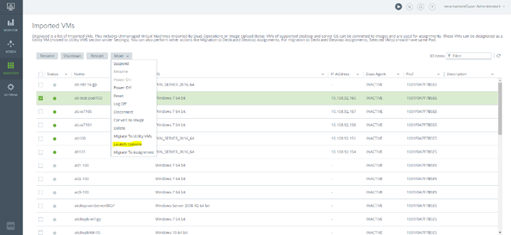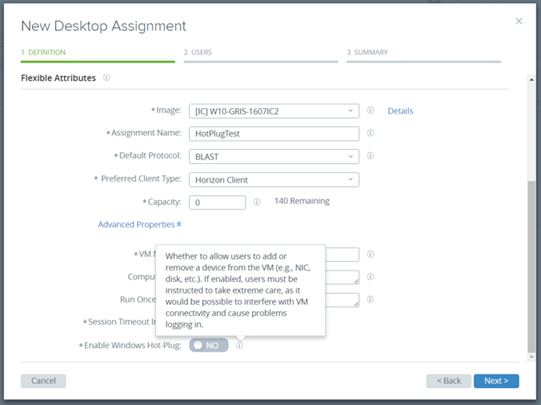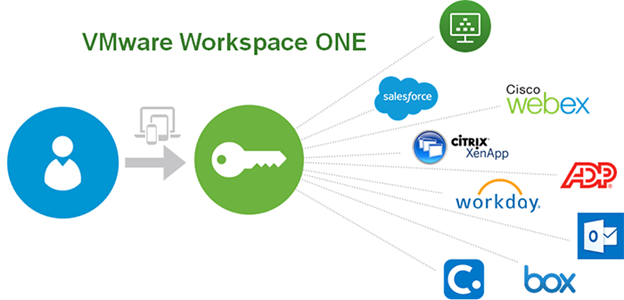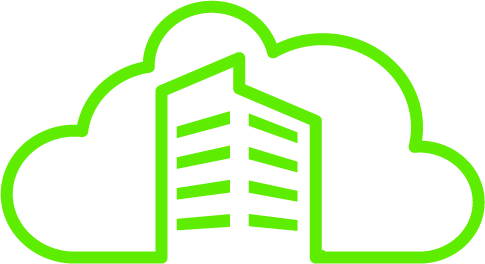Updates to Horizon Cloud with Hosted Infrastructure
Horizon Cloud with Hosted Infrastructure is the simplest way for you to deliver virtual desktops and applications from the cloud. Avoid the hassle and cost of managing your own infrastructure and deliver virtual desktops and apps in the cloud with managed infrastructure from VMware.
The latest release of Horizon Cloud with Hosted Infrastructure is rolling out to a datacenter near you. Built from the same platform as Horizon Cloud on Microsoft Azure, you can now take advantage of new features with this release.

Separation of Entitlements from RDSH Hosts
One of the first enhancements is how the Horizon Cloud service handles RD Session Hosts. Prior to this release, you had to entitle users to applications available on specific RD Session Hosts. Now you can create and utilize RD Session Host farms in Horizon Cloud Hosted. This gives you an additional layer of abstraction to user and application assignments.
With this update, RDSH Farm apps are added to the application catalog (including manually defined apps directly in the catalog). Users are assigned apps from the catalog and entitled to access them on the farms that you select.
By abstracting application delivery and assignment for RD Session Hosts into farms, Horizon Cloud now provides more efficient workload management for your users. You can also be more precise when entitling individual applications to users or user groups, rather than giving them entitlements to all applications on a single RD Session Host.
URL Redirection & File Redirection
For several use cases, it is desirable to redirect web access based on the requested URL. For example, an organization may want to redirect URLs residing outside the corporate intranet (such as yahoo.com) to the local client browser, while intranet domain URLs might be serviced via the VDI guest OS browser.
URL Content Redirection can both improve security and reduce unnecessary virtual desktop bandwidth when users browse certain Internet content. URL Content Redirection works with both virtual desktops and applications delivered via RDSH. For more information on URL Redirection in Horizon Cloud, see the Assignments section of the Horizon Cloud with Hosted Infrastructure Administration Guide.
Changes to RD Session Hosts
RD Session Host management changed significantly in the current release of Horizon Cloud Hosted Infrastructure. In the past, you had to manage RD Session Hosts individually for your environment. With this release, you now have RD Session Host Farms to better manage user and application assignment in RD Session Hosts.
RD Service Host Farms
A farm is a collection of Microsoft Remote Desktop Services (RDS) hosts that provide multiple users with session-based desktops and applications. Farms simplify the management of the RDS hosts. You can create farms to serve groups of users that vary in size or have different desktop or application requirements. A farm can provide either session-based desktops or remote applications.
To assign session-based desktops or remote applications to end users, import an RD Session Host VM into Horizon Cloud Hosted Infrastructure and create a base image from that imported VM. Then create the farms to serve those desktops and applications.
RD Session Host Rolling Maintenance
You can now schedule rolling maintenance of RD Session Hosts in Horizon Cloud with Hosted Infrastructure. There are two ways to trigger a rolling maintenance: by a weekly or daily schedule, or by the number of sessions delivered.
The Rolling Maintenance feature is set up during RD Session Host Farm creation. Set a rolling maintenance schedule to either restart or recreate each RD Session Host during the maintenance event.

Restarting a host executes a rolling restart based on the defined trigger (scheduled or session). Recreating a host refreshes each RD Session Host, causing it to be destroyed and then re-created based on the base image identified during Farm creation. You can set a minimum amount of hosts to be available during any maintenance cycle. This ensures that your users have enough capacity to continue working during the maintenance cycle.
Regular maintenance on your RD Session Host farm helps you to automatically keep the farm running at optimal condition with minimal downtime from a user point of view. It also helps you to deploy new, fresh images out to your farm on a timely basis. For more information, see the Horizon Cloud with Hosted Infrastructure Administration Guide.
Automatic Agent Pairing and Bootstrap
Agent pairing now occurs automatically when you create an image. You do not need to manually configure Agent Pairing with each image or configure the DaaS agent after installing.
Console Session Access in UI
For some time, VMware provided Horizon Cloud Hosted Infrastructure administrators with functionality to troubleshoot VM images and base deployments with a tool called HACA (Horizon Air Console Access). With this release, you can now launch console access into VMs that are being prepared as images for use in Horizon Cloud. The tenant administrator can now access any offline VM or image. This enables you to troubleshoot issues or modify a VM image within the system.
For more information, see the Assignments section and the Imported VMs section of the Horizon Cloud with Hosted Infrastructure Administration Guide.

Emergency Access via RDP
In the extremely rare case where a Horizon Cloud with Hosted Infrastructure broker is unavailable, you can instruct all DaaS agents to allow temporary RDP native access so that users can connect to their desktops without the broker and still be functional. This feature gives you more options to ensure that users experience as little downtime as possible.
Disable Hotplug on Desktop Assignment
Restrict users from adding or removing hardware peripherals from their VMs when they connect through the Horizon Client. Some examples include:
- Serial Ports
- Parallel Ports
- Floppy Drives
- CD/DVD Drives
- USB Controllers
- PCI Devices
- Ethernet adapters
- Hard drives
- SCSI devices
Doing this gives you better security against malicious activities by users on their own VM (such as adding a NIC to an untrusted network manually). You can leverage this feature on Traditional or Instant Clones, or with RD Session Hosts.

Integration with Workspace ONE and True SSO
Horizon Cloud Hosted integrates with VMware Workspace ONE. End users can access their VMware Horizon Cloud virtual desktops from the Workspace One application catalog and utilize single sign-on for authentication.
True SSO provides a way to authenticate to Microsoft Windows, retaining the users’ normal domain privileges, without requiring them to provide AD credentials.
For more details on configuring True SSO with Horizon Cloud Hosted Infrastructure, review the steps in the Configure True SSO for an Active Directory Domain section of the VMware Horizon Cloud Service documentation.

Horizon Cloud Monitoring
Horizon Cloud now has enhanced monitoring capabilities built in to the service. You can now monitor basic connection history, utilization of the service, and service health. Review reports on user and group entitlements and capacity utilization. With this feature, you can go to a single location to manage all critical components of the service.

The Horizon Cloud Monitoring service is currently deployed in the US, but will be added in other regions soon.
Summary
VMware Horizon Cloud with Hosted Infrastructure provides the fastest way to deliver virtual desktops and remoted applications from a cloud service. For more information on Horizon Cloud, see:








